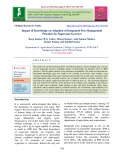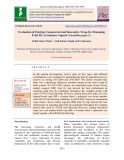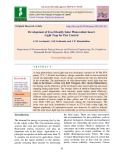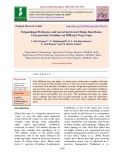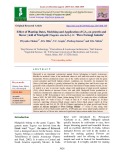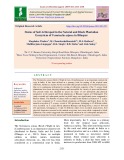
Different trap crops
-
The study was carried out during 2013-14 in Meerut district of Uttar Pradesh state to focus on the sugarcane growers regarding impact of knowledge on adoption level of IPM practices. The 80 contact farmers were selected as respondents. The study revealed that the maximum knowledge gap was found to be existing in previous crop residues, crop rotation, hand picking of the insect and their destruction, hot air and water treatment, light and pheromone trap, microbial control, use of natural enemies, resistant varieties, biopesticides/ bio-agents, application and dose of different pest etc.
 7p
7p  chauchaungayxua6
chauchaungayxua6
 26-06-2020
26-06-2020
 15
15
 1
1
 Download
Download
-
The method of preparation of mass inoculum (MI) of native AM fungi was standardized following the principle of multiplying the nucleus inoculum (NI) of AMF (consortium of native soils) under partially sterilized in situ. Inoculation of arbuscular mycorrhizal fungi in root zone soils of different agricultural crops for which treatment no. 17 (Fenugreek –MaizeSorghum) host trap crops was found to be suitable for their mass multiplication.
 18p
18p  caygaocaolon2
caygaocaolon2
 11-03-2020
11-03-2020
 13
13
 2
2
 Download
Download
-
In the present investigation, twelve types of lure traps with different combinations were evaluated for monitoring the fruit fly population for two seasons i.e. during 2017-2018 and 2018-2019. The studies revealed that, there was a significant difference recorded among all the twelve traps in both seasons. For 2017-2018 season, in commercial traps, Green victory methyl eugenol (ME) fruit fly trap showed the best performance in capturing adult fruit fly population throughout the cropping period with catch of 479.33 fruit flies/trap.
 7p
7p  caygaocaolon3
caygaocaolon3
 09-03-2020
09-03-2020
 11
11
 0
0
 Download
Download
-
A solar photovoltaic insect light trap was developed consisted of 10 Wp SPV panel, 12 V; 7 Ah lead acid battery, charge controller, dusk to down electrical circuit and adjustable stand. As per design calculations the trap was fabricated in the workshop. The performance of solar photovoltaic insect light trap was taken in the farmer’s cotton crop field Vazegaon, Dist. Akola (Maharashtra), for finding out the efficiency of the developed solar insect light trap and insect trapping during night hours.
 7p
7p  trinhthamhodang3
trinhthamhodang3
 12-02-2020
12-02-2020
 11
11
 0
0
 Download
Download
-
Four different trap crop plants viz, napier grass, sudan grass, sorghum and bajra were assessed for their potential role as a trap crop in the management of spotted stem borer Chilo partellus (Swinhoe) on maize. Oviposition preference and larval survival tests were conducted in screen house under semi controlled conditions. Results revealed that napier grass was greatly preferred for oviposition over maize but the larval survivability was very poor.
 5p
5p  chauchaungayxua3
chauchaungayxua3
 07-02-2020
07-02-2020
 16
16
 0
0
 Download
Download
-
An extensive survey for the diversity of mymarid fauna, internal solitary egg parasitoid was conducted in different agroecosystems of Tamil Nadu, during August 2018 – April, 2019. A total number of 1901 mymarid specimens were collected by using yellow pan traps in different cropping ecosystems viz., mango, sapota, grapes, brinjal, red gram, cotton, coffee, medicinal plants, and marigold. The mymarids were identified upto generic level.
 6p
6p  nguathienthan2
nguathienthan2
 26-12-2019
26-12-2019
 20
20
 0
0
 Download
Download
-
Marigold is an important commercial annual flower belonging to family Asteraceae. Besides its aesthetic value; it has medicinal values as well and roots used as trap crop for nematodes. Flower production seems one of the viable options to explore with the great export potential and North Indian climatic conditions are favorable.
 12p
12p  quenchua2
quenchua2
 15-12-2019
15-12-2019
 16
16
 0
0
 Download
Download
-
The Terminalia arjuna (Roxb.) Wight & Arn. (Combretaceae) is an important commercial crop in India. It has been utilized as a primary food for rearing of the tropical tasar silkworm, Antheraea mylitta by the rural and tribal people in India as a livelihood practice. Due to its continuous utilization for rearing of silkworm, majority of the T. arjuna block plantations have been showing sickness and susceptible for variety of pests and diseases.
 8p
8p  kethamoi2
kethamoi2
 14-12-2019
14-12-2019
 9
9
 0
0
 Download
Download
CHỦ ĐỀ BẠN MUỐN TÌM








